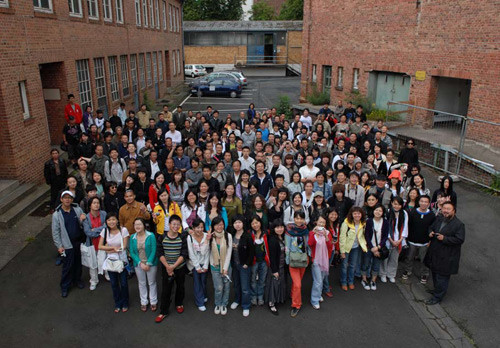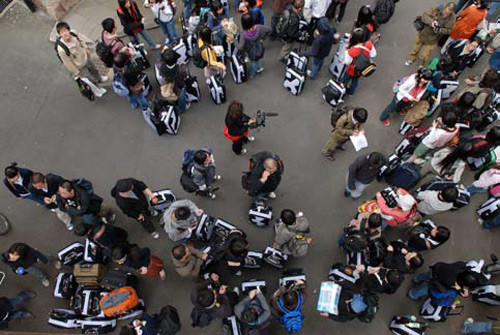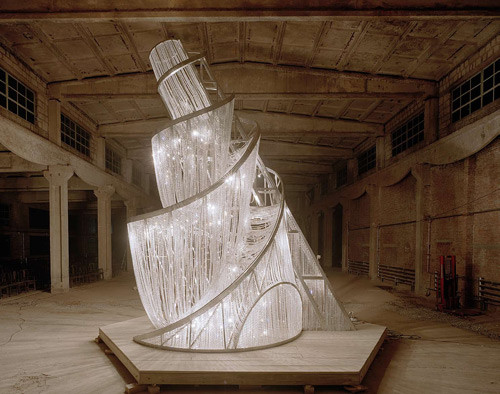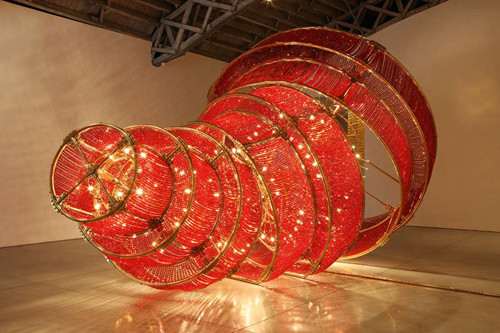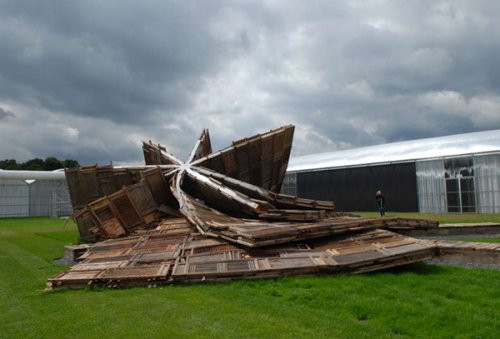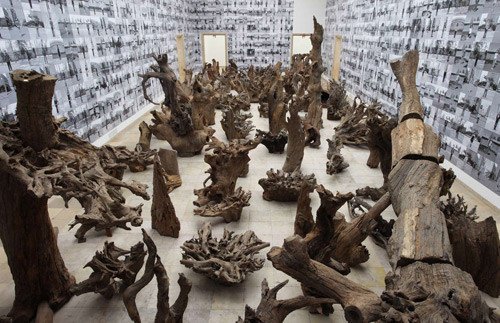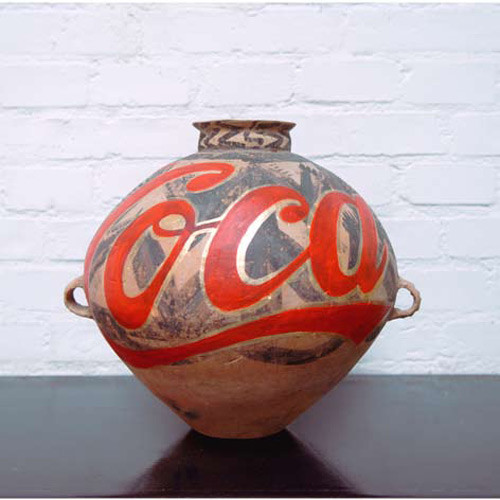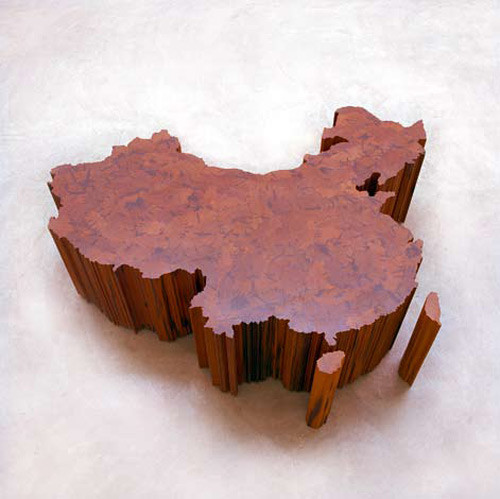Ai Wei Wei
Published: February, 2010, ZOO MAGAZINE #26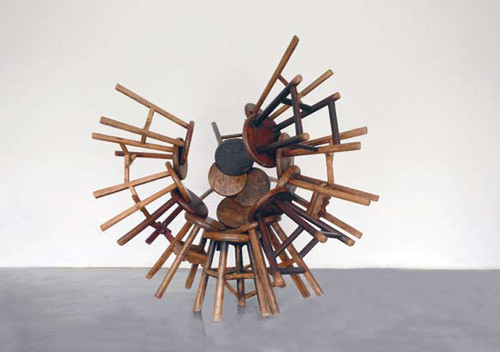
Ai Weiwei is a phenomenon: artist, architect, curator and political activist, someone who can adopt Western artistic ideas without forgetting his Chinese cultural heritage. His formal language is as clear and touching as his political ideals. His belief in the universality of human rights and the translation of this belief in action has inspired many in China and abroad. Here, Ai Weiwei shares his ideas about his art and art in general, his thoughts on society and politics, his vision for China and his role in creating a new form of social participation.
Marta Gnyp: I would like to start by talking to you about art and your visual language and personal iconography. You work often with antique chairs, chandeliers and furniture. For example, in one of your works, you used 1001 doors and windows from destroyed Ming and Qing dynasty houses. Is it a kind of provocation to use objects of national pride as cheap material?
Ai Weiwei: No, it is not a provocation; using old materials is a way of dealing with our past. We are giving our judgment about the past when we are referring to our tradition.
MG: But I understood from your earlier interviews that you are not happy with nationalism and nationalistic symbols.
AW: I don’t care about nationalistic symbols. I have been working in China for years so I’m using these objects as a part of my own tradition. Our history has been always related to our present; our history has always been reinterpreted, and using it in my art is a kind of evidence of the past.
MG: Are you using personal symbols in your art?
AW: Yes, but I don’t even know them. They just happen in my art. They all can be destroyed; it is for me not a matter of importance.
MG: As from the 17th century, there seems to be a dialogue between Western art and Chinese art. A few Western artists came to China and their influence was—at least according to Western art history—visible in Chinese art. For example, the use of shadow in painting came through Western artists…
AW: We have never used a shadow in our art, even not today.
MG: Why is that? Do you not care about the illusion of space?
AW: I think that for the Chinese, the art has never been representational. We use art as a method of analyzing and describing what reality is. But our artistic interpretation of the real world has never been done through scientific methods. We don’t want to make the artwork look like an object in reality, which has been the Western tradition until very late. China has never had this kind of problem. I think that as from the very beginning, we have been much more profound in understanding what art is and that art doesn’t have to copy nature.
MG: Art is much more about the intrinsic values of the thing as such than about its representation.
AW: Yes.
MG: Do you think that this approach could influence Western art?
AW: I think that the contemporary movement in the Western art of the last century was quite influenced by the Oriental way of thinking. The accent on the concept and not on the realization is similar to our understanding of art.
MG: I would like to talk with you now about your project, Fairytale, in Kassel in 2008. You brought 1000 Chinese who had never been abroad to Kassel because, as you described your project, there is a potential for change in a new place which is related to the strength of a personal experience. Did you consider this project as a socialcultural experiment or as an art project?
AW: I don’t think there is a conflict between the two approaches. Anything can be art if we are conscious about it. This project was a new way of expression and a charming way of communication. I couldn’t think of political or social involvement, which is not art.
MG: Were you happy about the result of the project?
AW: I’m very, very satisfied about the result because it brought to me new consciousness of what art should be and because it really extended the territory of art for me.
MG: It is very interesting because, for you, art seems to mean how you experience the world and it doesn’t limit itself to one territory.
AW: I think art is like water; it can flow and can get into action in any kind of shape. Art is not a territory but magic. We cope with our lives so we should not be away from our consciousness and our passions. Art gives us access to it.
MG: Do you think that you changed the life of the people you brought to Kassel?
AW: Many of them said this experience changed their life. For some of them, it was a dream; some started really a new life. They faced a different culture and were able to learn how to make different judgments. I think this is a very important part of us: to help people to see new possibilities in terms of thinking. To make people be more conscious about their own life.
MG: It is a very beautiful goal indeed. I would like to put another question about the Chinese and Western cultural relationship. In 2007, an important exhibition was held in Brussels about 500 years of Chinese and European painting called Forbidden Empire. It referred to a book with the same title from 1932, whose message was that the physical distance between China and Europe became smaller in our time, but the psychological distance perhaps bigger than ever. What is your opinion about it?
AW: I think that art is a communication means and can overcome physical distance. Art can make us realize that we are so much the same. Besides, through art we can become appreciated because it makes us realize how much we are missing or how much we have got by chance.
MG: And what do you think of the hype over Chinese art in Europe in the last couple of years?
AW: China is without any doubt a new society with new cultural products. The country was closed up for such a long period that its culture and intellectual concepts became inaccessible and surrounded by mystery. China, as each society, has always had some special cultural approaches that are based on their peculiar philosophical points of view. That triggered the curiosity of the West. Part of the hype came from that; of course, the other part came from the marketing, so these two aspects combined made Chinese art a very interesting phenomenon.
MG: Have you seen the exhibition of Chinese art at the Saatchi Gallery in London in 2008?
AW: No, I didn’t give it a lot of attention.
MG: Viewing this exhibition, I had a strong feeling that the Chinese artists were trying to copy European art, using European symbols and European philosophers. It was a bit disturbing because there was a lack of own message but rather a competition of forms and effects.
AW: Many Chinese artists are learning the contemporary art by copying the theory and forms. But besides this, there are good artists in China who have got a lot of appreciation.
MG: Is there a strong artistic community in China?
AW: I don’t think there is a strong one, but there is a big structure of artists. Unfortunately, China today is not a country of artistic theoretical exchange; it is still at a stage where no open discussion about ideas and ideology can take place.
MG: In 1997, you founded the China Arts Archives & Warehouse, which offer a platform for young and experimental artists. Is there a special kind of art or artists you want to support?
AW: Yes. It is art that is somehow related to thinking on concepts of our current situation in China.
MG: Are Chinese artists reflecting on art of the 20th century or, more specifically, art produced during the Cultural Revolution?
AW: So far I haven’t seen any art which you could call a form of reflection on the Cultural Revolution because the Cultural Revolution in general is not a topic that can be discussed. Art from that time was a part of a bigger system. We still don’t know what had really happened at that time.
MG: You used to live in New York between 1981 and 1993. Did you try to develop a universal language of art during your stay in America? Do you think we can communicate at all?
AW: Yes, any good art is a form of communication. My experiences from New York are very important for me today. It gave me a basis for my contemporary thinking and thanks to this basis, I can function well today in China.
MG: You once said that you consider Chinese art history as very important and rich. Do you think Chinese contemporary artists will go back to their own roots or will they seek to connect with the international trends of the art world?
AW: I don’t think that Chinese artists will go back to the traditional roots; it is a language of too long ago. We know where we come from, we know where we are today, but we cannot capture the past any longer.
MG: It could create, however, another issue. China underwent enormous changes in the last two decades. Many ideologies have been deconstructed. Does it create a problem for artists versus the more traditional public?
AW: Exactly. It is a very difficult, very shattered and broken relationship but we have to deal with it. We haven’t developed a common language yet.
MG: Do you think that you can convince the public to start to appreciate a different kind of art and different kind of ideology?
AW: I don’t really know. We have to see. I have no expectations.
MG: Do you get more appreciation for your art in the West or in China?
AW: In the West. I have never had any exhibition in China yet; the most discussions about my art are taking place in the West.
MG: Would you like to change it?
AW: Of course, this is why I’m working on my blog every day. I want my work to be really meaningful for this society—this society, which hasn’t experienced the freedom of speech yet and is a subject of a strong ideology control every day. Maybe one day they will understand my endeavors.
MG: You said once that you don’t like your own art works. Why not?
AW: To work on one object is a part of a totality. How to deal with communication, how to really be hopeful for the whole situation needs a lot of skills. I’m trying to achieve this but so far I’m not really proud if it. I’m always looking for a better expression of what I want to say in totality.
MG: You said in a previous interview that you don’t like people—you were referring to well-known artists—who don’t make moral judgments. Are you making moral judgments with your art? Do you think that art is intended to make moral judgments at all?
AW: I think art is a part of our society; art is a part of the product of us as human beings. I don’t think any aesthetics can be treated separately from the moral judgments. Art is a part of our total responsibility for the world. Otherwise I don’t see why we should make art.
MG: But don’t you think that art is also a place where you can experiment outside morality?
AW: I don’t think so. Any aesthetic judgment is a part of morality. I don’t think you can avoid it. People who pretend to avoid it make simply a different political statement.
MG: In relation to making political and moral statements, I would like to ask you about your contribution to Bird Nest Stadium in Beijing. Your contribution to this project is very controversial, seemingly also for yourself. A public sculpture with no sense of center but freedom became a piece with heavy different moral connotations for you. What made you change your mind about your contribution?
AW: When I realized it would be an object of a political propaganda. Initially we wanted to design something for society, which would be a symbol for democracy and freedom. But when we realized it goes to the opposite, the propaganda of the party, I decided not to be a part of it because it became a contradiction to my intentions.
MG: But before you started to work on this project, did you really believe that you could work freely and that there would be no involvement from the party?
AW: No, not like this. I really believed that it was a project which could help China to become more open because it would force China to accept the same values as in the other parts of the world. But of course, later I realized that it didn’t work as I thought it would, so I had to make my own judgment and take the consequences.
MG: Speaking about China and its openness to the other, you once said that Chinese are no longer Chinese but a unity connected with the world. Do you believe that the belonging to the world took over belonging to a national or social group?
AW: China underwent many significant transformations in the last decades. After a few years full of enthusiasm, a real struggle for the society has begun. You can see that China today is still struggling towards a different moral culture, but of course, our own tradition and historical models have an influence on what we are doing. But we can see a big change towards Western contemporary thinking.
MG: Do you think people are ready for this change?
AW: I think people are ready for it because our society became the second biggest economy in the world. It implies a challenge in communication with the world.
MG: Could you think of form of democracy which embraces nationalism in a light way?
AW: Each country has a different character. But the basis of each system should be rooted in fundamental social values and human rights.
MG: Is respect for these fundamental human rights what you want to achieve through your political activism?
AW: It is about the individual versus the state power. I cannot avoid speaking if the state ideology doesn’t respect the fundamental rights of the individual.
MG: You see a change towards contemporary Western thinking. Is there not a fundamental discrepancy in approach between Western and Chinese concepts because the concept of individuality is different? Is the concept of a collective in China not more important than that of the individual?
AW: You can have individualism in collective thinking. You have to find a new balance and a new lawful, judicial practice. I’m sure that there is an alternative and there are possibilities. But you need to trigger the consciousness and ideology to achieve that.
MG: This would be enormous work. What about consciousness and ideology in the art system?
AW: It is an old, dying system that is not related to contemporary art or contemporary thinking. This approach is very problematic because it is about skills, which, of course, could be important as a kind of private language but it is not the essential value of art.
MG: Is there censorship with regard to arts?
AW: If you don’t do anything against the current conditions than there is no censorship. But if you begin to question political and social issues, then you could have a problem.
MG: Would you like to have more support from other colleague artists in China in your fight for human rights?
AW: There is almost no support from the others, which is fine. Everybody should do what he or she considers as necessary. For me, this fight is an absolute necessity. I don’t mind if there is no support. For me, it is what I have to do.
MG: In an interview you gave in 2008, you said that you didn’t feel any danger. After what happened last year, do you still have the same feeling that you don’t feel threatened?
AW: No. I feel very much threatened. There are several people I know who have been sentenced to jail for five or ten years. You have to spend your life in jail only because you believe in an ideology that differs from the one of the party. It is terrible, but what can we do? If we don’t speak hard for others, things will never change and the next generation will still think the same. Somebody has to speak hard. I can speak hard so I have to do it.
MG: Would you consider leaving China because of personal danger and to continue your activities from abroad?
AW: No, I think it is more efficient if I stay in China. It is a good example for the young generation and it would be a completely different statement if I were to work from outside. We need free thinking.
MG: I can imagine that your personal example is very powerful. Do you expect that the young generation will take over your fight and that they will understand you better than the older generation?
AW: I think so. The new generation understands more and we have great communication.
MG: I assume you can communicate with them also thanks to your activity as a blogger?
AW: I’m active as a teacher. Every day, I spend four to eight hours on teaching and discussing current issues on a Chinese site. With 140 words in Chinese, you can write a novel. The Chinese are very efficient.
MG: So every day you are talking at least four to eight hours with young people through the Internet. What are the subjects you are discussing?
AW: Anything. Culture, art, politics, social issues, anything. My life means teaching, learning, communicating and making art.
MG: This means that free access to the Internet is extremely important for you.
AW: I think that the Internet is the best source of information in China.
MG: I read your article in the Wall Street Journal about Google’s position in China. Do you think that other companies will react like Google? That they will try to stop censorship or even the abuse of Internet by the Chinese government?
AW: It would be great if other companies would take a similar position, but it would be very difficult. Most companies are looking for a good business relationship with China so it is almost impossible that they will take any steps against the system.
MG: What do you expect from Google?
AW: I don’t really know. It could be any kind of result. What is very important is that they made a choice. They made it loud and everybody heard it.
MG: So you believe that making a statement, only making statements, makes people conscious about what is going on?
AW: That is very important. Everybody has to make statement. Art is about making statements.
MG: What would you do if China became a democratic country?
AW: Still, we would have a lot of problems, even in a democratic country. We will always have plenty of work.
MG: At this moment, you are active as an artist, curator, architect and political activist. Which one would be the most important job for you in the coming years?
AW: To live like an honest person, to live in a reality and act according to all my passions and will.
